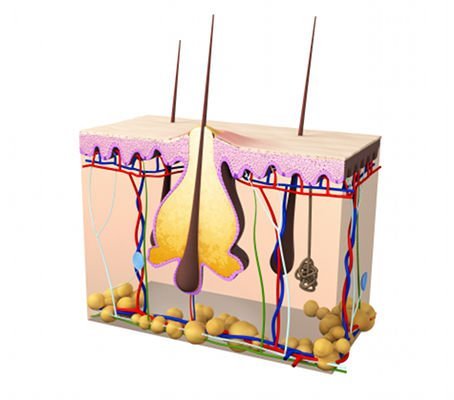Acne is one of the most common global pathologies. It affects 80% of women aged 14 to 17 and 90% men aged 16 to 19. Both active acne and its scarring consequences are a serious aesthetic problem that to date has been difficult to treat due to the aggressiveness and adverse effects of conventional solutions for acne treatment, such as resurfacing or antibiotics and retinoids.
IML has developed and optimised a new clinical protocol, product of its own clinical investigation: Acne Repair IML is based on laser technology and was presented before the Medical-Scientific Community at the Spanish Society of Medical-Surgical Laser Congress in June 2009.
Acne is a chronic inflammatory pathology of the pilosebaceous follicle characterised by the presence of lesions, inflammatory or not, with different levels of severity and distributed without following a homogenous pattern throughout predisposed regions, such as the race, neck and back:

A combination of excess sebaceous production and pore obstruction, caused by inappropriate cell flaking, favours the proliferation of bacteria which leads to local inflammation creating pressure that can rupture the wall of the follicle, transforming the micro pimples into inflammatory ones that evolve towards papules, pustules and nodes, signs of the most severe type of acne.
The IML Acne Repair IML protocol's aim is to reduce the severity and duration of the clinical symptoms, prevent scarring and control relapses. The procedure can be performed through two action mechanisms:
P. acnes is the most common microorganism in acne, it produces a series of photosensitive substances known as porphyrins. The light delivered by LED or intense pulsed light devices induces changes in the porphyrins with the production of toxic substance that destroy the bacteria.
This manages to reduce over infection and improves the inflammatory lesions. Keeping in mind that acned skin has a higher tendency to infection by P. acnes, regular treatment with LED or IPL is recommended to control relapses.

The IML Acne Repair protocol´s aim is to reduce the severity of acne
This technology delivers laser light in the shape of high precision micro-columns that reach the deepest skin layers without affecting the skin surface. These heat columns produce thermal coagulation that reduces the inflammation of the dilated skin vessels, destroys the sebaceous gland and activates fibroblast metabolism, responsible for the generation of new collagen and elastin. Therefore, non-ablative fractional Lux 1540 laser acts both on the active acne outbreaks as well as on the after-effects:
The procedure is fast, safe and painless. Non-ablative fractional laser is applied on clean skin, with several passes over the treatment area. It causes temporary reddening that remits 2 or 3 days later and can easily be camouflaged with light makeup. The patient can resume their normal daily activities immediately after applying treatment. IML recommends a minimum of 4 sessions, with one month rest between each session.
According to a study performed by IML, 75% of the patients treated with Acne Repair IML have experienced improvement of at least 75% in their acne lesions after just 4 treatment sessions.
For personalised information of acne treatment, contact IML now and we will give you a free informative consultation with one of our medical experts.